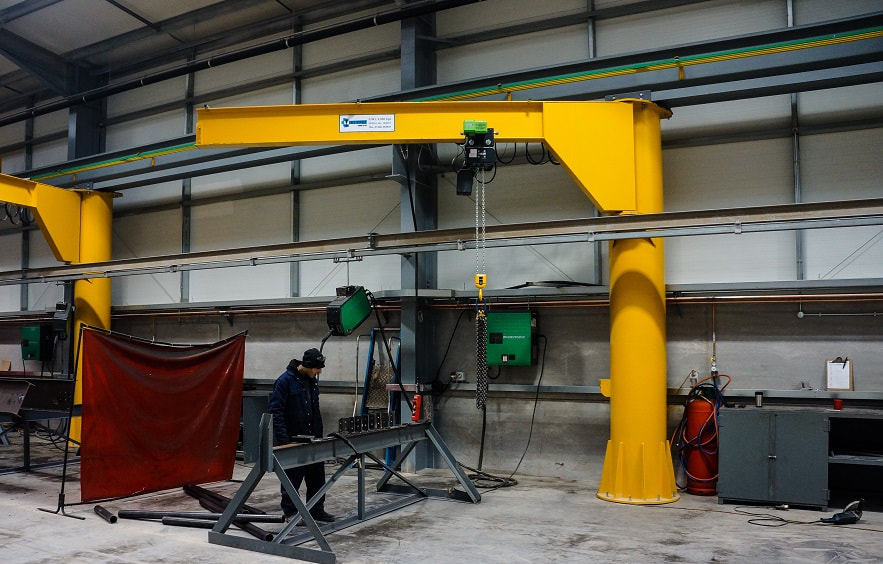What are jib cranes? What is their construction? How do they work? What types of jib cranes are there? Learn all about one of the simplest and most used cranes.
What Is a Jib Crane
Depending on the weight needed to be lifted and the space available, different types of cranes are used. One such type is the jib crane. Made up of a support beam (pillar) that is mounted on the wall or floor, it supports a horizontal jib with a movable hoist. The hoist then is used paired with a drum to lift or lower objects using chains or ropes. Such machines can be operated manually, electrically or with gas.
Jib cranes are not only used in construction jobs, but also on commercial and military vehicles (although these are usually for lighter lifting jobs, as they have limited power). They are really important because they save time and relieve the overhead crane.
There are three types of jib cranes:
Floor-mounted type
Sometimes refereed to as 'Freestanding' this crane model is made up of all the parts that are listed above. It is really useful as it can rotate 360o.Designed for machinery and maintenance industries for safe and easy moving of heavy or awkward items, it's most commonly used for weight support for the main cranes. You can find a floor-mounted jib crane for sale on the internet.
Wall mounted type (fixed)
This jib crane is placed horizontally on the wall surface and instead of a piller like the floor jib has a reinforced concrete column (RCC). It can rotate only 200o due to the RCC bracket, but it still covers the area around the bracket if the floor is not obstructed.
Wall mounted type (travelling)
The construction of this jib is very similar to the fixed type, the only difference being that runway tracks it's mounted on. This gives it the ability to not only reach around the bracket but also travel along the wall on the tracks if not obstructed.
Advantages of Jib Cranes
Even though they are simple in design, jib cranes are one of the most useful tools, that shouldn't be underestimated. Some of their benefits include:
Jib cranes are not only used in construction jobs, but also on commercial and military vehicles (although these are usually for lighter lifting jobs, as they have limited power). They are really important because they save time and relieve the overhead crane.
There are three types of jib cranes:
- Floor-mounted
- Wall mounted (fixed)
- Wall mounted (travelling)
Floor-mounted type
Sometimes refereed to as 'Freestanding' this crane model is made up of all the parts that are listed above. It is really useful as it can rotate 360o.Designed for machinery and maintenance industries for safe and easy moving of heavy or awkward items, it's most commonly used for weight support for the main cranes. You can find a floor-mounted jib crane for sale on the internet.
Wall mounted type (fixed)
This jib crane is placed horizontally on the wall surface and instead of a piller like the floor jib has a reinforced concrete column (RCC). It can rotate only 200o due to the RCC bracket, but it still covers the area around the bracket if the floor is not obstructed.
Wall mounted type (travelling)
The construction of this jib is very similar to the fixed type, the only difference being that runway tracks it's mounted on. This gives it the ability to not only reach around the bracket but also travel along the wall on the tracks if not obstructed.
Advantages of Jib Cranes
Even though they are simple in design, jib cranes are one of the most useful tools, that shouldn't be underestimated. Some of their benefits include:
- Strong – Due to their fixed bases, even small jib cranes have the strength to hoist a few tons.
- Secure – It is their simple design that makes them reliable and secure, with so little parts the change of breakdowns is reduced, and even if it does happen can easily be spotted and fixed before any major damage is done.
- Simple – They can be operated by even new workers, because they consist of so little axes, making them one of the simplest machineries.
- Swift – They are fast, which allows them to move objects very quickly in their radius of reach, saving time and allowing workers to devote their time and energy on other activities.

